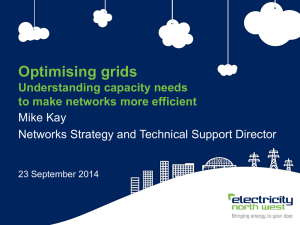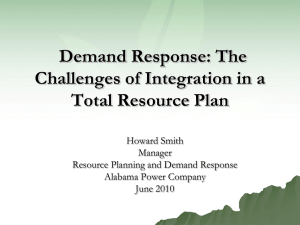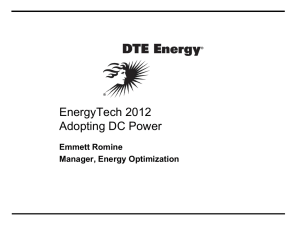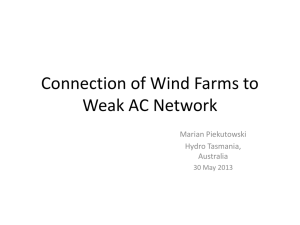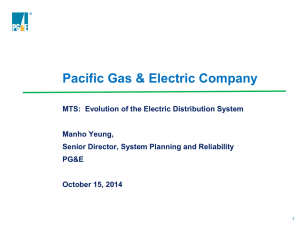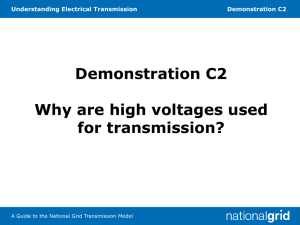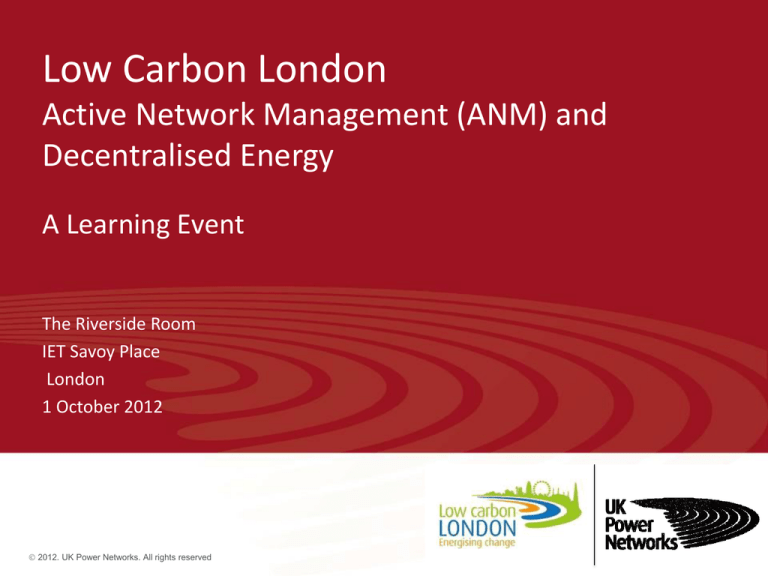
Low Carbon London
Active Network Management (ANM) and
Decentralised Energy
A Learning Event
The Riverside Room
IET Savoy Place
London
1 October 2012
2012. UK Power Networks. All rights reserved
Welcome
• Housekeeping and safety
• Introduction to the afternoon
2
Low Carbon London – a learning journey
Learning how to create a smart, low carbon city
A pioneering demonstration project, trialling new low
carbon technologies, commercial innovation and
design, operation and network management
strategies…
• Smart Meters
• Residential ToU – demand flexibility to respond to
availability of renewable generation
• Demand Response with Industrial & Commercial (I&C)
customers
• Distributed Generation & Active Network Management
(ANM)
• Electric Vehicles
• Heat Pumps and Small Scale Embedded Generation (SSEG)
• Engineering Instrumentation Zones
• New Tools, Operational and Investment Practices
• Learning Laboratory – learning dissemination
3
Enabling Distributed Generation
Challenge:
UK Low Carbon Transition Plan: 30% of UK electricity from renewable
sources by 2020
Mayor of London’s renewable strategy target: 25% of electricity and
heating from local generation by 2025
Our response:
Investigate the impact and enable the connection of distributed and local generation to the
distribution network and trial Active Network Management (ANM) techniques to assess how
they improve security of supply and reduce network investment costs
‘CONSTRAINING OFF’ – monitor and facilitate DG connections to the
LV and HV distribution networks
‘CONSTRAINING ON’ – active management of DG to ensure security
of supply and postpone network reinforcement
The best and most cost-effective way to adapt the electricity network to accommodate
4
large amounts of distributed generation
Purpose of the day
• What is Active Network Management (ANM)?
• How ANM can be used to support the electricity network and
to manage the increasing connections of low carbon
technologies (CHP, PV etc.)
• Outline of the Low Carbon London trial proposition and
recruitment process
• Lessons learnt and current barriers to recruitment
• Group discussions to suggest ways to overcome the barriers
• Smarter Grid Solutions ANM demonstration
5
Low Carbon London Learning Event
Growing grid capacity to power change
Colin Gault
October 2012
Confidential
© 2012 Smarter Grid Solutions Ltd.
Contents
Introduction to Active Network Management (ANM)
Constraints on Network Capacity
Thermal
Voltage
Fault Level
Application of ANM
7
Confidential
© 2012 Smarter Grid Solutions Ltd.
ANM increases capacity in the existing grid
Cost effective and
timely connections
Avoid or defer
network upgrades
8
Maximise existing
assets
Confidential
© 2012 Smarter Grid Solutions Ltd.
ANM provides a new layer in grid management
9
Confidential
© 2012 Smarter Grid Solutions Ltd.
Electricity Network Constraints
• Network constraints represent a barrier to increased penetration of
distributed energy resources
• Network constraints are derived from the physical characteristics of the
electricity network and the standards that govern electricity supply
• Three main network constraints are:
– Thermal (Power Flow)
– Voltage
– Fault Level
• Other technical (e.g. power quality) and non-technical constraints can
exist (e.g. commercial arrangements)
10
Confidential
© 2012 Smarter Grid Solutions Ltd.
Thermal (Power Flow) Constraints
• The flow of current produces heat within electrical conductors (I2R)
• Conductors are assigned a maximum operating temperature
• Exceeding this operating temperature can reduce the lifetime of
equipment or result in overhead line conductors breaching safety
clearances
• Assumptions are made about environmental conditions and conductor
cooling to calculate a maximum current or power carrying capacity for
every circuit section, known as the thermal rating
• Thermal ratings have traditionally been employed as a static variable with
variations occurring between the different seasons of the year only
• Some components can tolerate an exceedence of thermal ratings for a
defined period of time, known as the cyclic or short-term ratings
11
Confidential
© 2012 Smarter Grid Solutions Ltd.
Thermal (Power Flow) Constraints – Network Design
• Traditional approach has been “fit and forget” for the connection of load
customers
• Design of network for connection of load considers power flows during the
maximum load scenario
• Estimates of future load growth are taken in to account to minimise
network reinforcement
• Design of network for connection of generation considers minimum load
maximum generation scenario (worst case)
• Generator connections dealt with individually with no consideration of
expected growth or interactive nature of applications
• Planning standards, “Engineering Recommendation P2/6: Security of
Supply”, sets out how much network you need to ensure security and
reliability for demand customers
12
Confidential
© 2012 Smarter Grid Solutions Ltd.
Thermal (Power Flow) Constraints – Example 1
G
Firm Generation
Rated Export = 6 MW
Conductor Rating = 5 MW
L
Minimum Load = 1 MW
Maximum Load = 5 MW
Acceptable Level of Firm Generation = Minimum Load + Conductor Rating
Acceptable Level of Firm Generation = 1 MW + 5 MW
Acceptable Level of Firm Generation = 6 MW
13
Confidential
© 2012 Smarter Grid Solutions Ltd.
Thermal (Power Flow) Constraints – Example 2
Transformer Rating = 25 MW
G
Firm Generation
Rated Export = 30 MW
G
Non–Firm Generation
Rated Export = 25 MW
L
Minimum Load = 5 MW
Maximum Load = 25 MW
Transformer Rating = 25 MW
Acceptable Level of Firm Generation = Minimum Load + (1 X Transformer Rating)
Acceptable Level of Firm Generation = 30 MW
Acceptable Level of Non-Firm Generation = 1 X Transformer Rating
Acceptable Level of Non-Firm Generation = 25 MW
14
Confidential
© 2012 Smarter Grid Solutions Ltd.
Voltage Constraint
• Voltages on the electricity network must be maintained within statutory
limits
– 230V +10% / - 6%
• Ensures quality of supply and the correct operation of equipment
• Network operators penalised if voltage outside of statutory limits
• Sudden changes in voltages – step voltages – large enough to be
noticeable to humans (e.g. light flicker) are undesirable and avoided
wherever possible
• Sources of energy increase network voltages and consumers of energy
decrease network voltages
15
Confidential
© 2012 Smarter Grid Solutions Ltd.
Voltage Constraint – Network Design
• To minimise network losses electricity is transmitted across long distances
at high voltage
• Network voltage tapers toward end users
• Traditional view of network is that power flows from high voltages to low
voltages and this is reflected in network design and operating practices
• Voltage control is achieved in various ways:
–
–
–
–
Tapping of transformers
FACTS devices (mainly at transmission)
Reactive compensation devices, e.g. capacitors and inductors
Operating generators in PV mode (utilises reactive power capabilities to fix
voltage)
16
Confidential
© 2012 Smarter Grid Solutions Ltd.
Voltage Constraint – Example 1
Circuit 1
Automatic Voltage
Control (AVC) Relay
Primary Substation
L
L
L
L
L
L
Circuit 2
Upper Limit
Feeder 1 – Max L
Voltage
Feeder 2 – Max L
Lower Limit
Increasing Distance From Substation
17
Confidential
© 2012 Smarter Grid Solutions Ltd.
Voltage Constraint – Example 2
Circuit 1
AVC
L
L
L
G
Circuit 2
Primary Substation
L
L
L
Generator raises
voltage profile
Circuit 2 – Max G Minimum L
Upper Limit
Voltage
Circuit 2 – Max G Maximum L
AVC varies
voltage at
busbar
Lower Limit
Circuit 1 – Max L
Increasing Distance From Substation
18
Generator masks load
at primary substation
and disrupts operation
of AVC relay
Confidential
© 2012 Smarter Grid Solutions Ltd.
Fault Level Constraint
• Fault levels relate to the magnitude of the current that will flow into a
particular node on the electricity network if a short circuit fault were to
occur at that node
• Fault current is produced by both generation and load and is dependent
on the impedance of the network between the location of the fault and
sources of fault current
• Circuit breakers and protection relays are installed and configured at
strategic locations on the network to isolate and remove a fault quickly
and safely
• Fault Level as a constraint is concerned with the rating of circuit breakers,
which are designed to operate for fault currents up to a specific
magnitude
19
Confidential
© 2012 Smarter Grid Solutions Ltd.
Fault Level Constraint – Network Design
• Fault level is not readily measured in the same way as current and voltage
• Fault levels calculated using off-line analysis tools
• Effects of different network configuration considered with fault level
analysis due to resultant change in network impedance
• Circuit breakers chosen with a design rating greater than the worst
expected fault current – headroom allocated for future growth
• Fault levels re-assessed as new sources of fault current are connected to
the network
• Fault current can be limited by increasing network impedances through
splitting parallel paths or using high impedance equipment
– Increases network losses and reduces network security
– Fault current limiting devices are appearing on the market and being tested by
DNOs
20
Confidential
© 2012 Smarter Grid Solutions Ltd.
Fault Level Constraint – Example 1
Circuit Breaker (CB)
I1
CB1
I total
CB3
CB2
Fault
I3
I total = I 1 + I 2 + I 3
CB3 Rating >= I 1 + I 2
L
I2
G
Fault current contribution of short-term parallel generators
also considered
21
Confidential
© 2012 Smarter Grid Solutions Ltd.
Fault Level Constraint – Example 2
Standard running
arrangement with 3
transformers run split
T1
T2
T3
N-1 running
arrangement with 2
transformers run split
Fault
T1
In the standard running arrangement
total fault level contribution is split
between 3 transformers
T2
T3
T3
Isolated
In the N-1 running arrangement
total fault level contribution is
split between 2 transformers
22
Confidential
© 2012 Smarter Grid Solutions Ltd.
Application of Active Network Management
•
Identify network constraint(s) through power systems analysis
– Thermal, Voltage or Fault Level
– Locations
•
•
Select appropriate Active Network Management application
Perform feasibility assessment
– Uses historical data and network topology as input
– Provide estimates of energy production/consumption (MWh)
•
Confirm commercial arrangements
– Principles of access, e.g. Last In First Off, Shared, etc.
•
•
•
•
•
Requirements gathering
Detailed design
Deployment
Support
Add further controlled devices or constraints
23
Confidential
© 2012 Smarter Grid Solutions Ltd.
Application of Active Network Management
• Thermal (power flow) constraint
–
–
–
–
Measure power flow in real-time
Control generation or load when power flow exceeds limit
Exploit fluctuation in demand and generation
Utilise latent network capacity to maximise low carbon energy production
• Voltage Constraint
– Measure voltage in real time
– Control generation, load or operating position of any voltage control devices
installed on the network when voltage breaches limits
– Exploit fluctuation in demand and generation
– Fully co-ordinate load, generation and network devices to maximise utilisation
of latent network capacity and voltage headroom
24
Confidential
© 2012 Smarter Grid Solutions Ltd.
Application of Active Network Management
• Fault Level Constraint
– Co-ordinate connection of generation to the network ensuring fault level
contribution does not exceed fault level limits
– Co-ordinate multiple generator intertrip schemes during network
reconfiguration
– Exploit difference between what generation could be connected to the
network and what generation is connected to the network at any point in time
25
Confidential
© 2012 Smarter Grid Solutions Ltd.
Centralised or
Decentralised
Location
Controllable Energy
Storage System
L
M
M
L
L
M
Controllable
Generation
AVC
Controllable Load
Primary Substation
G
L
M
M
M
L
M
M
M
L
Measurement Point
Controllable Load
26
Confidential
© 2012 Smarter Grid Solutions Ltd.
ANM – SECURITY OF SUPPLY
Paul Pretlove
UK Power Networks
27
Security of Supply - Requirements
• Requirements described within:
– Distribution Code – DPC4
– Engineering Recommendation P2/6
– Engineering Technical Reports 130 and 131
• Distribution Price Control Settlement (DPCR)
– Capital and Operational expenditure
– Customer Interruption (CI) and Customer Minutes Lost
(CML)
28
Security of Supply – Requirements Cont…
FCO
SCO
29
Security of Supply – Calculation (Current)
30
Security of Supply – Calculation (Current)
Load
• Current
• Forecast
Contribution to security of supply
• Network Assets
– Manufacturers information and engineering assumptions
• Transfer capacity
– Network design and configuration
• Distributed Generation
– Probability based analysis
31
Security of Supply – Calculation (Current)
Challenges associated with calculating the contribution from
Distributed Generation:
• Information unavailable
• Resource intensive and time consuming
Consequences:
• Risk averse approach to under estimate the contribution from
Distributed Generation
– Over engineered network
• Inability for consideration in operational decisions
– Increase in Customer Interruptions (CI) and Customer
Minutes Lost (CML)
32
Security of Supply – Calculation (Proposed)
33
Security of Supply – Calculation (Proposed)
Challenges associated with calculating the contribution from
Distributed Generation:
• Information unavailable
• Resource intensive and time consuming
Consequences:
• Risk of over/under estimating the contribution from
Distributed Generation
– Under/over engineered network
• Inability for consideration in operational decisions
– Increase in Customer Interruptions (CI) and Customer
Minutes Lost (CML)
34
Security of Supply – Calculation (Ambition)
35
Security of Supply – Calculation (Ambition)
Under contract with owners of Distributed Generation to
contribute to the security of supply
• DNO benefits
– Maximise use of existing assets
– Greater interaction with customers
• Customer benefits
– Additional revenue stream for the DG owners
– Lower energy bills for all customers, as DNO’s use
“smarter” use of their assets
36
LOW CARBON LONDON
Recruitment to Decentralised Energy ANM Trial
Chris Taylor
UK Power Networks
37
Customer Recruitment - Overview
• Engagement strategies (three approaches)
– Approach One – tailored/targeted recruitment
– Approach Two – higher level recruitment
– Approach Three – mass targeted recruitment
• Accent Active Network Management Research
• Summary of current recruitment challenges
38
Approach One – Tailored/Targeted Recruitment
• Selection process prioritising existing customers (security of
supply trials)
– Hierarchy of selection criteria
1.
2.
3.
4.
Type of connection
Technology (low carbon technology)
Location (near constrained main substation)
Size
– Customers meeting criteria 1 – 3 were contacted directly
o 10 customer met this criteria
o 1 successful contact
• Selection process for identifying new customers (enabling and
security of supply)
– No material leads
39
Approach One – Tailored/Targeted Recruitment
Learning and challenges identified:
• resource intensive
• difficult to obtain appropriate contact information
• technically unable to participate
• low uptake
40
Approach Two – High Level Recruitment
• Higher level contact with interested organisations
– trade associations (CHPA, GLA, London First, UK District
Energy Association etc)
– CHP operators/providers
– leverage internal customer relationships
• During this recruitment stage we contacted around 30 customers
and CHP installers/operators
– one firm lead
– multiple other possible leads (in excess of 30)
41
Approach Two – High Level Recruitment
Learning /challenges identified:
• Occupancy arrangements being a barrier to implementation:
– multiple decision makers
– no financial benefits for party owning/managing the
generator
• A significant number of people were technically unable to
participate:
– enabling – fault level issues
– security of supply
o no modulation of output
o inability to “dump” heat
42
Accent – ANM Research
• Why?
• Findings:
– Financials /Incentives /Benefits
– Communications
o Clients /Customer -> too complex
o Consultants / Manufacturers -> too simplistic, lacking detail
– Requirement for full time recruitment resource in order to
follow up leads effectively
• The results of this research partly triggered Approach Three
43
Approach Three – Mass Targeted Recruitment
• Accent survey
• Introduction of monitoring only trial
– existing customers selected based on meeting selection
criteria 1 (type of connection)
• Increase in resource
– dedicated customer liaison manager
– ‘hot house’ sessions involving the whole LCL team.
– all leads periodically followed up via email and phone
• Third party specialist engagement
44
Current Recruitment Challenges
• Unwilling to have third party equipment installed on premises
• Unable to obtain contact information for the customer or contact the
decision maker within the organisation for programmes of this nature
• Unable to obtain correct level of management buy in
• No tangible benefits to participation
• Not enough time or resources available to consider the opportunity
• General unwillingness/negative response to ‘cold calling ‘ approach
• Lack of understanding of the concept of the trials and see the value
they can add as a participant
• No response to any type of contact (email, phone, letter)
• Third party assistance difficult
45
Table Discussions to Support Approach Four
46
Closing Statements
• Questions
• Smarter Grid Solutions ANM demonstration
• Refreshments and networking
47

